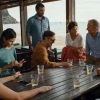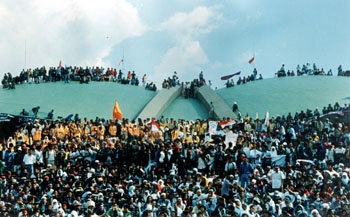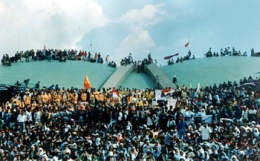Along Indonesian history, student is a crucial element in social transformation. Their critical spirit and revolutionary attitude succeeded in toppling down authoritarian regime. The beginning of student movement in Indonesia can be tracked back at the founding of Boedi Oetomo (1908) involving one of the pioneers, Soetomo, and with “rakyat berdaulat” (“people power”) mission. Twenty years afterwards, at 1928 precisely, Sumpah Pemuda (Youth’s Vow) was being declared with the same will, “satoe tanah air, satoe bangsa, dan satoe bahasa” (one country, one nation, and one language).
In the year of 1942, Indonesian students’ movement continued to struggle by using international diplomacy aimed for Indonesian independence. When Indonesian independence being declared (17/08/1945), their movements were focused on guarding Indonesian independence. Therefore, many students were involved in armed military resistance.
The year of 1955 was notable as a difficult year for the student movement. Student movement which supposed to be a moral and intellectual force trapped at political practice. It is proved by HMI (Islamic Student Union) affiliation to Masjumi (Indonesian Islamic Council) Party, GMNI (Indonesian National Student Movement) affiliation to PNI (Indonesian National Party), CGMI (Indonesian Student Movement Central) affiliation to PKI (Communist Party of Indonesia), PMKRI (Catholic Student Union of Indonesia Republic) affiliation to Parkindo (Indonesian Catholic Party), and other similar student movements that had affiliation with political party. After ten years under Soekarno regime, by the upcoming of ’65 tragedy, the student movements found their momentum in returning their personality as a moral and intellectual movement. By the massive student movement, soon Soekarno was being overthrown from his power (1966).
After the fall of Soekarno, many students were being involved in the Orde Baru (New Order) political practice. It made them no longer be a student with a criticism towards the ruler’s policies. In fact, the New Order government was a worse and corrupted regime which notable by the piling of foreign debts, acts that violating the human rights, and many other systemic crime by the state. This is why democracy under the New Order was perished.
In such sorrowful condition, the students committed protest in the street to demand for a better change. It was noted as Malari (January 15 Tragedy) which committed by the students because the government were not people’s oriented in the development policies. Three years afterwards at 1977, Ikrar Mahasiswa (Student’s Vow) was declared by the students to force Indonesian legislatives in insisting President Soeharto’s responsibility for his violating act towards UUD 1945 (Indonesian Constitution) and persisting the returning of ABRI (Indonesian Armed Military Force) to the people. This act was responded by shutting down any space and instrument in campus that were potentially used for students’ criticism. This action was overcomed by a policy named NKK/BKK (Campus Life Normalization/ Campus Coordination Beaureu).
Indonesian people under The New Order kept on degrading in any aspect of life and reached climax in 1997. Indonesian student movement showed up everywhere. They demand a change and this movement also succeeded in forcing Soeharto to end his power. Unfortunately, this success was not followed by an ideal infrastructure constructing. This resulted in a conclusion: 1998 reform only able to change the ruler and not able to create a more democratic politic culture. It is being worse because a similar condition with student movement’s condition in 1955 and 1965, where many ex-student activists were entering political practice.
The involvement of 1998 student activist to political practice brings enormous effect to students’ criticism towards the regime’s elite politicians. This is caused by the unique relation between elite politicians and student activists which are similar in both ideology and organization where the elite politicians were members when they were still a student activist. Therefore, after the fall over Soeharto, student movement configuration has no power to make a change like 1998 student movement.










